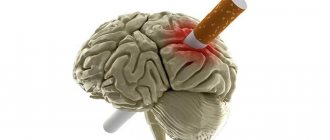The cerebrospinal fluid spaces are filled with cerebrospinal fluid, which transports nutrients and regulates the level of intracranial pressure.
The distribution of cerebrospinal fluid within the skull is ensured by the subarachnoid space, the third and fourth ventricles.
The movement of cerebrospinal fluid is ensured by cardiac activity, body position, the respiratory cycle, and the movement of epithelial cilia. Normal indicators of intracranial pressure are ensured by the optimal amount of cerebrospinal fluid - 140 ml.
The expansion of convexital spaces is detected by ultrasound and MRI in newborns. Acquired forms of nosology in infants occur after traumatic brain injuries. Doppler ultrasound (USDG) allows for timely diagnosis of pathology before the fontanelles of the skull close. In other cases, magnetic resonance imaging reveals the disease. The procedure is harmless to the baby's health. For high-quality results, a motionless position is required during the scan, so the procedure is performed for the child under anesthesia.
MRI of expanded cerebrospinal fluid spaces
How is dilatation of subarachnoid convexital spaces treated?
This aspect deserves special attention. The disease is very difficult to determine in the early stages, since it is often asymptomatic.
It is important to understand that signs of expansion of the subarachnoid space of the brain may differ for each person. They depend not only on the form and stage of the pathology, but also on the characteristics of the human body.
According to doctors, in most cases, patients experience the following symptoms:
- severe migraines;
- nausea and vomiting;
- blurred vision;
- increased drowsiness;
- mixing of brain structures.
As medical practice shows, most often the intensity and severity of clinical manifestations increases in the evening, and in the morning the patient feels a noticeable improvement. However, if left untreated, the disease will continue to progress. As a person's condition worsens, the risk that they will fall into a coma increases.
In the early stages, the pathology can be treated, but local expansion of the subarachnoid spaces cannot be completely cured due to irreversible changes in the brain.
In this case, the consequences can be very different - from disruption of normal life to death.
Therefore, if you notice the first symptoms of hydrocephalus, do not hesitate, but immediately go to the hospital.
Treatment of expansion of the subarachnoid space
Since the pathology is caused by an increase in the content of cerebrospinal fluid or a violation of its outflow, diuretic therapy is prescribed. Patients use diuretics (Furosemide).
For cirrhosis, ascites and hydrocephalus in adults, Veroshpiron, an aldosterone antagonist, is indicated. Glucocorticoids also have an anti-edematous effect and reduce the intensity of exudation during the inflammatory process.
To eliminate convulsive syndrome, anticonvulsants are used.
For diplococcal and streptococcal meningitis, antibacterial drugs are used, having previously tested the sensitivity of the microflora to them. To treat viral encephalitis, specific immunoglobulin is used.
For anatomical defects caused by congenital pathologies or injuries, surgery is indicated to improve the drainage of the cerebrospinal fluid tract of the brain and spinal cord.
Conclusion
Expansion of the subarachnoid space, especially in early childhood, can lead to dementia, a serious decrease in intellectual functions, and disability. Therefore, urgent surgical resolution or drug therapy aimed at the symptoms and pathogenesis of the disease is necessary.
Hydrocephalus in medical practice is characterized as dropsy in the brain. This condition refers to excessive accumulation of cerebrospinal fluid in the cranial cavity.
Normally, there is constant circulation of cerebrospinal fluid. The substance in the spinal cord and brain is washed on all sides by a transparent, colorless liquid, which has various properties, the main ones being protection and providing additional nutrition.
External circulation of cerebrospinal fluid in the brain occurs between the choroid and pia mater throughout the entire surface of the hemispheres and cerebellum. This surface is called the subarachnoid space. In the cranial base under the brain there are several more areas of fluid accumulation. They are called tanks.
These areas, connecting to each other in different directions, form the cerebrospinal fluid subarachnoid space in the brain and connect to a similar surface in the spinal cord.
The latter does not provide a system of channels and a protective-trophic system of cells. The subarachnoid space in the spinal cord behind the dorsal roots has a dense framework consisting of fibrous fibers intertwined.
It should be noted that plexuses are present only here. The lateral subarachnoid space does not have formations between the dentate ligament and the dorsal roots.
In front, between the soft and arachnoid membranes, there are collagen beams that do not create obstacles to the circulation of cerebrospinal fluid.
Source: https://xn--90ad0ar3a.xn--p1ai/obsledovanie/subarahnoidalnoe-prostranstvo-norma.html
Ependyma
The boundary surfaces of the liquor system in different places have different morphological structures. Most often they are three-layered: ependyma, glial fibers and glial cells underneath.
In different fields of the ventricles, ependymal cells have different structures.
Usually, cuboidal endothelial cells of cilia are found in the ventricles, but cilia are absent above the middle medial eminence of the neurohypophysis, in the pineal region and in other areas. These are usually sites that are involved in neuroendocrine regulation. In these special fields, the ependyma consists of two types of cells: dorsally located, ciliated, cuboidal ependymal cells with a centrally located nucleus, and ventrally located cells called tanycytes. The latter are without cilia, with an elongated dense core and a tail, which stretches and creates contact with the capillary wall (see figure). Tanycytes are believed to be involved in the transport of pituitary hormones.
Boundary surfaces can be two-layer or even single-layer. Glial cells are absent or the ependyma is located on top of the glial cells, without an intermediate layer of glial fibers. A single-layer structure, consisting only of flat ependymal cells, is sometimes found in the ventricular system and in the region of some paraventricular formations. At the ultrastructural level, close similarities can be observed between the villous epithelium and ependyma, including pinocytic vesicles, but compact junctions are not found in many areas of the ependyma. Therefore, at present, many authors do not recognize the existence of a liquor-brain barrier. Due to the absence of the latter, free diffusion of extracellular fluid into the cerebrospinal fluid and back is possible, which explains the very similar composition of these fluids.
Expansion of subarachnoid spaces of the brain in adults
20.03.2019
The subarachnoid space is a cavity between the arachnoid and pia mater of the brain, where cerebrospinal fluid circulates in an amount of 130 ml. There are cisterns here - places of slight expansion of the arachnoid and soft shells. It contains the largest amount of cerebrospinal fluid.
What does it mean
Expansion of the subarachnoid spaces is a pathological condition formed as a result of the influence of harmful factors on the brain, for example, traumatic brain injury, or a defect in fetal maturation.
The expansion of the subarachnoid spaces of the brain in adults is not an independent disease. This pathological condition reflects painful processes in the cranium.
Causes
Causes may be congenital or acquired. Congenital causes of expansion of subarachnoid spaces:
- Injuries to the fetus during the mother's pregnancy.
- Congenital defects in the development of the nervous system.
- Chromosomal abnormalities.
Acquired reasons:
- Trauma to the skull and brain.
- Neuroinfections: meningitis, encephalitis, inflammation of the arachnoid membrane.
- Brain tumors.
- Hemorrhagic stroke and minor hemorrhages.
- Brain swelling.
- Acute intoxication with heavy metals.
- Chronic heart, kidney and liver failure.
Inflammation of the membranes of the brain leads to the formation of adhesions. This impedes the circulation of cerebrospinal fluid, which leads to increased intracranial pressure and infantile hydrocephalus. Most often this appears after inflammation of a meningococcal, tuberculous and syphilitic nature.
During the period of manifestation of inflammation, the hemodynamics of the blood and blood vessels of the brain changes: the permeability of arteries and veins increases, and plasma enters the intercellular space. This causes swelling, which further increases intracranial pressure.
Tumors, being a voluminous process, compress brain structures and tissues, pinching lymphatic and blood vessels. This complicates the outflow of cerebrospinal fluid and blood, the brain becomes congested, the pressure in it increases and diffuse hydrocephalus occurs.
Expand the subarachnoid spaces and chronic diseases of the heart and kidneys. Due to disruption of the functioning of these organs, the outflow of blood from the brain worsens, which leads to a deterioration in the outflow of cerebrospinal fluid and intracranial hypertension. Less commonly, pathology is caused by poisoning with heavy metals: lead, bromine or mercury.
In newborns, the expansion of spaces is facilitated mainly by congenital malformations of the central nervous system and heart.
People with enlarged subarachnoid spaces may experience disturbances in the circulation of cerebrospinal fluid: excessive production of fluid and impairment of its utilization. These pathologies are considered as individual characteristics of a person.
Symptoms
Uneven expansion of the subarachnoid spaces of the brain in children is observed by the following symptoms:
- Irritation to bright lights, loud sounds and strong odors.
- Sleep disturbance.
- Vomiting immediately after eating.
- Crying for no reason.
- Damage to the oculomotor nerve, which manifests itself as strabismus.
- Pulsation and bulging of the fontanel, incomplete closure of the sutures.
- Trembling in the limbs and chin.
- Changes in behavior and reactions when the weather changes.
In adults, symptoms are:
- Liquorodynamic headache. Characterized by bursting and aching pain in the head. The symptom is accompanied by dizziness, nausea and often vomiting, which brings temporary relief to the patient.
- Mental disorders: emotional lability, irritability, tearfulness, apathy, agitation. Decreased concentration, memory deterioration and slower pace of thinking. Intolerance to bright light, loud music and strong odors. Sleep is usually superficial, intermittent, with difficulty falling asleep.
- Autonomic disorders: dizziness, loss of appetite, alternating constipation and diarrhea, excessive sweating, heart pain.
Over time, prolonged expansion of the subarachnoid spaces can lead to hypertensive encephalopathy.
This condition is caused by impaired cerebral circulation and liquor circulation, which causes diffuse or focal lesions of the cerebral cortex.
The disease is accompanied by severe headaches, restlessness and anxiety, impaired consciousness in the form of syncope or somnolence.
With developed encephalopathy, memory decreases, attention is distracted and intelligence decreases. Also, with the progression of the disease, an asthenic syndrome forms: patients become irritable, weak, and exhausted. They increase anxiety and are prone to depression.
Diagnosis and treatment
Instrumental methods help diagnose the expansion of spaces:
- Neurosonography. A method accessible to everyone, including children and pregnant women.
- Computed and magnetic resonance imaging.
- Cisternography. A contrast agent is injected into the brain cisterns, after which X-rays are taken.
The goal of treatment is to relieve intracranial hypertension, reduce symptoms and improve the patient’s standard of living.
After determining the etiology of the enlargement, the underlying disease is treated. For example, in case of a tumor, surgery is prescribed to remove the tumor; in case of infections, antibacterial or antiviral agents are prescribed. After eliminating the underlying disease, symptomatic therapy begins.
Full treatment includes the following appointments:
- Diuretics to relieve cerebral edema and reduce intracranial pressure.
- B vitamins to restore nutrition to nervous tissue.
- Antibiotics and antivirals for the treatment of infectious diseases.
- Nootropic drugs for restoring cognitive functions.
- Analgesics for headaches.
Didn't find a suitable answer? Find a doctor and ask him a question!
Source: https://sortmozg.com/zabolevaniya/neravnomernoe-rashirnie-subarahnoidalnyh-prostranstv
Symptoms of the disease
Of course, like any disease, this pathology has its symptoms. In most cases, as mentioned above, it appears in young children, but sometimes there are older patients who can clearly describe the symptoms. Most often, expanded convexital spaces manifest themselves in the form of signs such as:
- persistent headache;
- dizziness;
- nausea;
- vomit;
- memory impairment (in adults);
- drowsiness;
- irritability;
- fatigue;
- increase in the size of the skull (in young children);
- increased sensitivity to light and auditory stimuli.
In the first stages, the disease may not manifest itself in any way, which significantly complicates timely diagnosis. The intensity of the manifestation of such signs directly depends on the type of deformation. In young children, these symptoms are a consequence of postpartum trauma, arachnoiditis or meningitis, and in adults they are a sign of a tumor in the brain or the result of a mechanical injury.
A mild degree of expansion is a violation of 1-2 mm, a medium degree is 3-4 mm, and a severe degree is more than 4 mm.
What is the subarachnoid space
The subarachnoid space lies between the meninges covering the nervous tissue - soft and arachnoid. The space is filled with cerebrospinal fluid and performs several important functions, including protecting nervous tissue from mechanical damage.
Liquor, which fills the area under the arachnoid membrane, serves as a shock absorber, smoothing out shocks, shocks and other adverse external influences. The expansion of the area of the interhemispheric fissure and the area of the subarachnoid space often indicates the development of pathology.
Definition
Subarachnoid is a space that is located between the meninges and is filled with cerebrospinal fluid, which determines its role and functions in the process of cerebrospinal fluid circulation.
The cerebrospinal fluid spaces provide protection and nutrition to the brain substance.
Liquor contains nutritional components necessary for the life of nerve cells, and also performs the function of removing end products formed during the metabolic process.
In places where the subarachnoid space is naturally expanded, cerebral cisterns are formed, which means that the main volume of circulating cerebrospinal fluid is contained in these cavities. Subarachnoid cisterns are areas of natural increase in the volume of the subarachnoid space, which are mainly located at the base of the brain of the head. The largest cisterns are the basal and occipital.
Arachnoid cysts often form in the quadrigeminal cistern, which, when growing, interfere with the normal flow of cerebrospinal fluid, which leads to an increase in intracranial pressure.
If the arachnoid space greatly increases in volume, compression of adjacent tissues (medullary substance, blood vessels, cranial nerves) occurs, which correlates with disturbances in the functioning of the brain and the entire body.
Uneven expansion of the subarachnoid space located in the brain is rare in adult patients. More often, pathology is detected in infants. In newborns, the volume of the subarachnoid cavity is normally smaller than in an adult. The medullary cisterns are part of the network through which cerebrospinal fluid circulates.
The cisterns are external reservoirs, while the ventricles are internal. If the processes of production and resorption (absorption) of cerebrospinal fluid balance each other, circulation is maintained in normal mode.
When the balance between the processes of production and resorption of cerebrospinal fluid is disturbed, hydrocephalus develops.
Hypertensive-hydrocephalic syndrome is manifested by an expansion of the zone of internal liquor spaces and corresponding symptoms.
The expansion of the interhemispheric fissure in infants is a disorder that reflects an abnormal formation of the structures that make up the brain, which can subsequently interfere with the normal development and adaptation of the child.
Pathology is detected during ultrasound or MRI studies. Normally, the size of the bladder does not exceed 3 mm. A slight increase in the size of the bladder is not a reason for diagnosing hydrocephalus or cerebral hypertension.
The normal dimensions of the subarachnoid space at 3 months do not exceed 3 mm in full-term infants, 4 mm in premature infants. The normal sizes of the cerebral cisterns are: the large cistern located under the cerebellum - up to 10 mm (sagittal section), the quadrigeminal cistern - up to 3 mm. The volume of circulating cerebrospinal fluid is about 120-140 ml.
It is worth noting that slight dilatation of the cerebrospinal fluid system of the brain in an infant or an adult does not require drug correction if it is not accompanied by neurological symptoms. Regular monitoring by a neurologist will allow you to monitor the process. If pathological symptoms are present, appropriate treatment is carried out.
Causes of possible pathologies
Moderate expansion of the subarachnoid space zone is a disorder that often indicates perinatal pathology, which is often associated with hypoxia, birth injuries, and the use of aids and instruments (birth forceps, cesarean section) for delivery.
The causes of congenital abnormalities of brain formation, leading to dilatation (expansion) of the cerebrospinal fluid tract in an infant, are often associated with intoxications, viral and bacterial infections suffered by the mother during gestation. The reason for the widened interhemispheric fissure often lies in a violation of cerebrospinal fluid dynamics, which leads to the accumulation of cerebrospinal fluid in this area.
Brain damage in the early stages of ontogenesis is the main cause of mortality in the perinatal period and leads to the occurrence of neurological pathologies in childhood in 70% of cases.
An increase in the volume of the meningeal space develops as a result of the formation of a cyst, tumor, hemorrhage or inflammatory process localized in the brain tissue.
Some infectious diseases of the central nervous system, including meningitis, provoke increased production of cerebrospinal fluid.
Cysts and tumors interfere with the normal flow of cerebrospinal fluid, which leads to its accumulation in the subarachnoid space and dilatation of the cerebrospinal fluid cavity. A short-term increase in cerebrospinal fluid production is associated with high physical exertion, stress, and mental fatigue. Disturbances in production and liquor dynamics are often associated with herbs in the head area.
Cortical dysplasia
Cortical focal (focal) dysplasia is the cause of the development of epileptic seizures, often resistant to drug therapy. Expansion of the subarachnoid space of the frontal and parietal lobes is often a marker of cortical dysplasia.
During an instrumental examination of the convexital surface of the brain, foci of damage to the nervous tissue are identified, caused by compression from the dilated cerebrospinal fluid-containing cavities. The MR picture of moderate expansion of the subarachnoid convexital space is combined with signs typical of cortical dysplasia:
- Thickening of the cortex.
- Blurred boundaries separating the structures of the brain matter - white and gray.
- Pathological changes in the venous sinuses.
- Macrogyria (abnormally wide gyri).
An increase in the volume of liquor-containing spaces against the background of repeated convulsive attacks is a reason for a thorough diagnostic examination in order to identify abnormalities in brain formation (vascular malformations, glial changes, tumors, cysts).
Cerebral atrophy
If the convexital grooves are widened, this may indicate atrophy of the medulla, which is fraught with the development of neurodegenerative diseases, including Alzheimer's disease. With cerebral atrophy, the density of brain tissue decreases and the volume of brain matter decreases.
The tendency to develop a condition where the subarachnoid convexital spaces and grooves are unevenly widened is a natural process of aging. With age, similar changes are observed in most people. According to research, after reaching the age of 40, the volume of cerebrospinal fluid increases by an average of 1 ml annually.
In the age period of 40-90 years, the volume of cerebrospinal fluid increases by 3-10%, as a result of which the liquor-containing spaces expand. Clinically, cerebral atrophy is manifested by a violation of higher cortical functions (deterioration of memory, mental activity, motor activity, changes in behavior).
Diagnostics
Nowadays, brain pathologies are quite easily diagnosed. For this purpose, hardware methods are used (ultrasound, MRI), and, if necessary, lumbar puncture. The latter allows not only to detect a tumor, but also to examine all its layers and structure. This method allows you to select the treatment regimen for cystic and other formations as accurately as possible.
Basic diagnostic methods:
- Neurosonography. Duration of the procedure
15 minutes. It is carried out when it comes to a newborn, and consists of attaching a special ultrasound sensor to the patient’s head. Through the open fontanel, it allows you to collect information about the state of the brain. The advantage of this method is that it can be performed frequently, without any consequences for the baby. Now neurosonography is done in the maternity hospital to exclude pathologies of brain development. The result is deciphered by a pediatrician or neurologist.
- CT, MRI. These methods, although effective, are expensive. They are mainly used to diagnose children over 3 years of age and adults. Now considered the most accurate. To diagnose infants, using CT or MRI is very problematic, since the patient must lie absolutely still during the procedure. If such a diagnosis is indicated for a small patient, it is performed under general anesthesia.
- Cisternography. The purpose of the procedure is to determine how correctly the flow of cerebrospinal fluid is directed. It allows you to accurately determine the type of hydrocephalus in a particular patient.
- Angiography. With this diagnostic method, a special contrast agent is injected into the artery. The goal is to identify deviations in vascular patency.
- Neuropsychological examination. The patient is examined and the doctor interviews him. This examination is carried out in children over 3 years of age and adults. The doctor collects the data from all tests and the results of a visual examination. The goal is to identify disorders in the functioning of the brain.
The results of an ultrasound or MRI should only be deciphered by an experienced doctor. Self-diagnosis is unacceptable and extremely dangerous here. It is very important to accurately establish the cause of the pathology and immediately begin to eliminate it. This directly affects the course of recovery and further functionality of the brain.
Congenital hydrocephalus
In this case, the expansion of the subarachnoid cerebrospinal fluid spaces of the brain develops in the child already when he is still in the womb. This condition is very dangerous, since the pathology continues to develop along with the baby and is impossible to control it in any way. The reasons can be very different:
- protrusion of the wall of the artery of Galen;
- thickening of the vein walls;
- basilar impression
- Arnold-Chiari malformation;
- cerebral hemorrhage;
- unsuccessful birth, during which the baby was injured;
- various infectious diseases suffered by the mother during gestation.
It is important to understand that even a slight expansion of the subarachnoid space in unborn children can cause the development of many serious complications. As medical statistics show, most babies are born with various mental disorders and diseases, as well as developmental defects, with which they will have to live until their death.
Types of pathology
The expansion of the subarachnoid spaces of the brain in adults and children can have a variety of forms, which have certain characteristics, course patterns and symptoms. But in modern medicine there are two main types of pathology:
- closed;
- open.
Let's take a closer look at each of them and find out what this disease is, what the consequences of lack of therapy are, and what clinical manifestations it is accompanied by.
Basic treatment methods
This aspect is worth dwelling on in more detail. If the expansion of the subarachnoid spaces of the brain has not yet developed into an acute or chronic form, then drug therapy is used to combat the pathology. The following indicators may serve as a reason for prescribing radical treatment methods:
- defects in the development of the structure of the cranium;
- some infectious diseases that occur in acute form;
- oncology;
- hemorrhage;
- focal accumulation of pus;
- spinal arachnoiditis.
If for some reason surgical intervention cannot be performed, then doctors create additional pathways through which the outflow of cerebrospinal fluid will occur. The therapy program is aimed not only at removing fluid, but also at eliminating the very cause that became the catalyst for the onset of the pathological process. Therefore, very often radical treatment methods are combined with a course of medications, which are selected by doctors individually for each patient depending on his age category, clinical picture and symptoms. In addition, you must strictly adhere to a special diet:
- eat foods rich in vitamins;
- reduce your daily intake of sugar and salt to a minimum;
- completely give up alcohol;
- drink as much fluid as possible every day.
If the patient seeks help from the hospital not too late, then the chances of a full recovery are quite high. But with an advanced form, as a rule, it is impossible to completely get rid of the consequences.
Replacement hydrocephalus
What is she? This expansion of the subarachnoid spaces of the brain in adults is extremely rare, since it does not manifest itself in its pure form. Most often, the pathology is caused by the death of cells in the cerebral cortex. As the atrophic process progresses, the soft tissues decrease in size, resulting in a free space in the skull that is gradually filled with fluid. However, its abduction is not impaired, so in most cases no therapy is prescribed. In very severe cases, doctors can resort to radical treatment methods, namely surgery, but this only happens in cases where there is a real threat to the patient’s life. Among the main provoking factors are the following:
- age-related changes in the structure of the brain;
- diseases of the vascular system;
- high blood pressure;
- poisoning of the brain matter with toxic components;
- Creutzfeldt-Jakob disease.
The expansion of the subarachnoid spaces of the brain in adults can occur in acute and chronic forms. In the first case, the pathology develops very quickly and unpredictably, and is also accompanied by intense and pronounced symptoms. At the same time, the patient’s clinical picture is constantly deteriorating. Drug treatment is useless, and the only effective method is surgery. In the chronic form, the pathology progresses more slowly, so a person’s well-being does not deteriorate so rapidly. Gradually, the patient's intracranial pressure increases and fluid accumulates in one or more parts of the brain. The main symptom of the disease is the psychological discomfort experienced by the patient.
Depending on the area in which the cerebrospinal fluid is localized, the pathology is divided into the following types:
- External replacement. Fluid accumulates near the outer parts of the brain and settles under its membranes.
- Internal. The main area of localization is the cisterns and ventricles.
- Mixed. It is something in between the two types described above.
In addition, uneven expansion of the subarachnoid spaces of the brain is also classified depending on the severity of the pathology. In a mild form, the patient does not experience any discomfort and does not notice symptoms, but in a severe form, he is haunted by severe pain of a neurotic nature.
Main provoking factors
Let's look at them in more detail. Expansion of the subarachnoid spaces of the brain in adults can occur due to a variety of unfavorable factors. A huge number of tests and studies have been carried out in medicine, however, doctors have not been able to fully study the etiology of the disease. Among the most common and confirmed reasons are the following:
- apoplexy;
- ischemia;
- disruption of normal cerebral circulation;
- cancerous tumors;
- alcohol abuse;
- previous head injuries;
- oxygen starvation;
- various infectious diseases;
- hemorrhage.
Depending on the etiology of the disease, signs of expansion of the subarachnoid space will differ. For treatment to be as effective as possible, it is necessary not only to make efforts to stimulate the drainage of cerebrospinal fluid, but also to eliminate the underlying cause that gave impetus to the development of the pathology. Therefore, after an initial examination of the patient, a specialized specialist sends him for a comprehensive examination.











